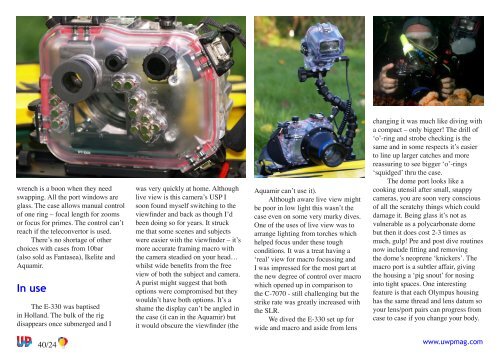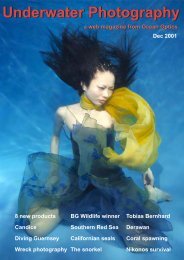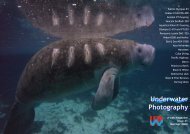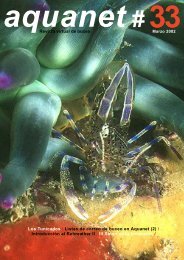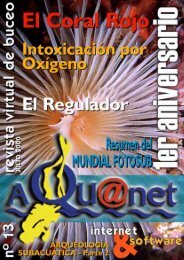Underwater Photography Underwater Photography
Underwater Photography Underwater Photography
Underwater Photography Underwater Photography
You also want an ePaper? Increase the reach of your titles
YUMPU automatically turns print PDFs into web optimized ePapers that Google loves.
wrench is a boon when they need<br />
swapping. All the port windows are<br />
glass. The case allows manual control<br />
of one ring – focal length for zooms<br />
or focus for primes. The control can’t<br />
reach if the teleconvertor is used.<br />
There’s no shortage of other<br />
choices with cases from 10bar<br />
(also sold as Fantasea), Ikelite and<br />
Aquamir.<br />
In use<br />
The E- 0 was baptised<br />
in Holland. The bulk of the rig<br />
disappears once submerged and I<br />
40/24<br />
was very quickly at home. Although<br />
live view is this camera’s USP I<br />
soon found myself switching to the<br />
viewfinder and back as though I’d<br />
been doing so for years. It struck<br />
me that some scenes and subjects<br />
were easier with the viewfinder – it’s<br />
more accurate framing macro with<br />
the camera steadied on your head…<br />
whilst wide benefits from the free<br />
view of both the subject and camera.<br />
A purist might suggest that both<br />
options were compromised but they<br />
wouldn’t have both options. It’s a<br />
shame the display can’t be angled in<br />
the case (it can in the Aquamir) but<br />
it would obscure the viewfinder (the<br />
Aquamir can’t use it).<br />
Although aware live view might<br />
be poor in low light this wasn’t the<br />
case even on some very murky dives.<br />
One of the uses of live view was to<br />
arrange lighting from torches which<br />
helped focus under these tough<br />
conditions. It was a treat having a<br />
‘real’ view for macro focussing and<br />
I was impressed for the most part at<br />
the new degree of control over macro<br />
which opened up in comparison to<br />
the C-7070 - still challenging but the<br />
strike rate was greatly increased with<br />
the SLR.<br />
We dived the E- 0 set up for<br />
wide and macro and aside from lens<br />
changing it was much like diving with<br />
a compact – only bigger! The drill of<br />
‘o’-ring and strobe checking is the<br />
same and in some respects it’s easier<br />
to line up larger catches and more<br />
reassuring to see bigger ‘o’-rings<br />
‘squidged’ thru the case.<br />
The dome port looks like a<br />
cooking utensil after small, snappy<br />
cameras, you are soon very conscious<br />
of all the scratchy things which could<br />
damage it. Being glass it’s not as<br />
vulnerable as a polycarbonate dome<br />
but then it does cost 2- times as<br />
much, gulp! Pre and post dive routines<br />
now include fitting and removing<br />
the dome’s neoprene ‘knickers’. The<br />
macro port is a subtler affair, giving<br />
the housing a ‘pig snout’ for nosing<br />
into tight spaces. One interesting<br />
feature is that each Olympus housing<br />
has the same thread and lens datum so<br />
your lens/port pairs can progress from<br />
case to case if you change your body.<br />
www.uwpmag.com


